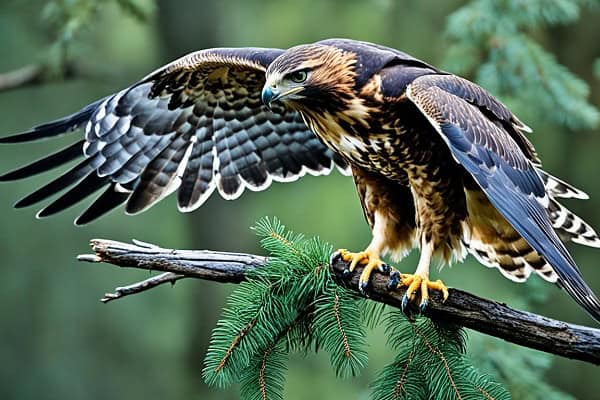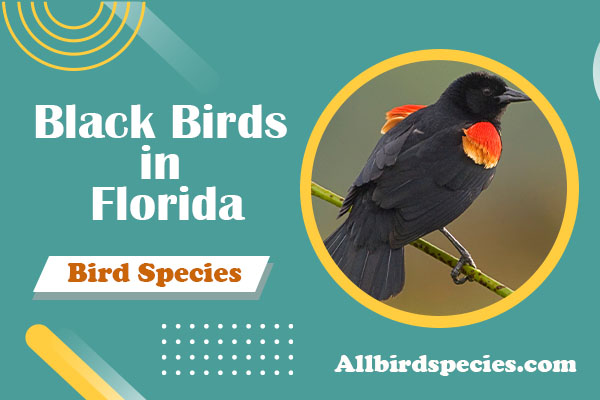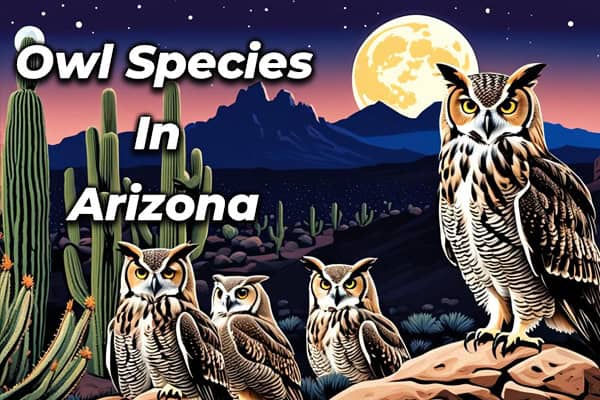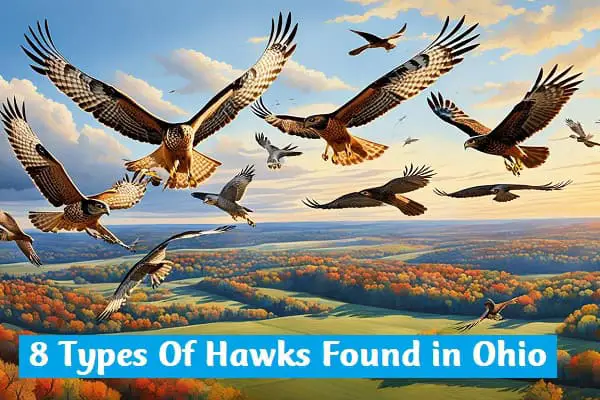11 Species Of Hawks in Arizona To Spot (With Pictures)
Did you know Arizona is home to over 30 types of raptors, including 12 kinds of hawks? These birds are not just beautiful; they are vital to our ecosystems. They help keep the balance by being predators.
As we explore hawks in Arizona, we’ll learn about their unique traits, behaviors, and where they live. Each hawk species is special in its own way.
From the high-flying Red-tailed Hawk to the sneaky Cooper’s Hawk, Arizona’s hawks are fascinating. They have special skills that bird lovers find interesting. Spotting hawks in Arizona is a great way to connect with nature and see these amazing birds up close.
Let’s explore the world of hawks in Arizona. We’ll find out where to see these amazing birds in the beautiful state!
~Common Hawk Species Found in Arizona~
- Red-Tailed Hawk
- Cooper’s Hawk
- Sharp-Shinned Hawk
- Broad-Winged Hawk
- Rough-legged Hawk
- Northern Goshawk
- Swainson’s Hawk
- Ferruginous Hawk
- Common Black Haw
- Harris’s Hawk
- Gray Hawk
- Zone-tailed Hawk
Introduction to Hawks in Arizona
Arizona is a top spot for bird lovers, with many hawks to see. The state has deserts, forests, canyons, and riparian zones. These places are perfect for hawks to live and thrive.
These birds are key to keeping our environment healthy. They can live in many places, showing how well they adapt.
The state’s landscape makes birdwatching exciting. You can see hawks in cities, parks, and the wild. Arizona’s variety of hawks makes each outing an adventure in nature.
| Habitat Type | Common Hawk Species | Typical Behavior |
|---|---|---|
| Desert | Red-Tailed Hawk | Soaring and hunting over open areas |
| Forests | Cooper’s Hawk | Perching quietly and hunting small birds |
| Canyons | Harris’s Hawk | Social hunting in groups |
| Riparian Zones | Common Black Hawk | Foraging near water bodies |
1. Red-Tailed Hawk
The Red-tailed Hawk is a bird that catches our eye in Arizona’s skies. It’s known for its unique look and hunting skills. Let’s explore its science name, how to spot it, where it lives, and how it hunts.

Scientific Classification
The Red-tailed Hawk’s scientific name is Buteo jamaicensis. This name helps us tell it apart from other birds in the Buteo group. It’s a key bird in North America, known for its wide range and adaptability.
Identification Features
Spotting Red-tailed Hawks is easy once you know what to look for. They are 19.7 to 25.6 inches long and have a wingspan up to 52.4 inches wide. Their reddish-brown tail is a key feature, along with their pale belly and dark upper body. Their call sounds like “keeeyah!” which makes them stand out.
Nesting and Hunting Behavior
Red-tailed Hawks build big nests in tall trees with twigs, grass, and leaves. They take great care to make a safe home for their young. These hawks are great hunters, catching small mammals, birds, reptiles, and carrion. They fly high to spot prey and then dive fast to catch it.
2. Cooper’s Hawk
We’re diving into the world of the Cooper’s Hawk. It stands out among other birds for its unique traits and behaviors. Known as Accipiter cooperii, this hawk catches our eye with its looks and how it lives in different places.
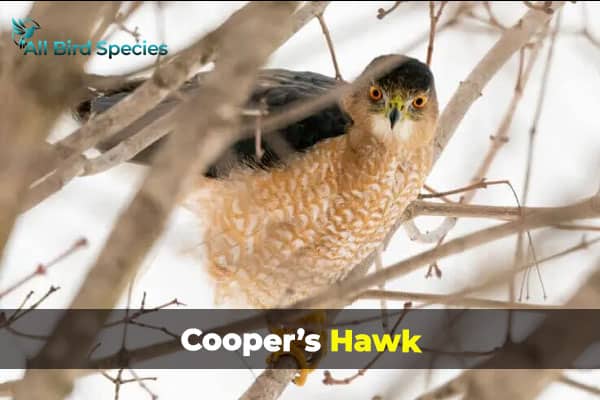
Physical Characteristics
The Cooper’s Hawk has a sleek, agile body. It’s 14.6 to 15.3 inches long and its wings spread up to 35.4 inches wide. It has a blue-gray back and reddish breast bars. Its red eyes help it see well for hunting.
Habitat Adaptations
Accipiter cooperii is very adaptable. It lives in woods, suburbs, and cities. It’s good at living in places changed by people. It builds nests in tree branches for safety during breeding.
Courtship behaviors, like sharing food, help pairs bond and mate successfully.
Feeding Habits
The Cooper’s Hawk eats small birds, showing it’s a top bird hunter. It uses speed to catch its prey. At backyard feeders, it’s quiet and quick, making it a great hunter in cities and nature.
3. Sharp-Shinned Hawk
The Sharp-shinned Hawk, Accipiter striatus, is a bird of prey known for its agility and unique look. It’s a thrill for those who love nature and watching birds. They are a sight to see in the sky.

Appearance and Size
Sharp-shinned Hawks are small, measuring 9.4 to 13.4 inches long. Their wings can spread up to 22.1 inches wide. This lets them move quickly through trees. They have a thin body, a squared-off tail, and sharp eyes for spotting prey from far away.
Nesting Behavior
Sharp-shinned Hawks build their nests in hidden spots, often high up in dense trees. They use sticks, leaves, and other materials to make their nests. These nests look like they’re part of the tree, keeping the young safe from danger.
This shows how well they adapt to living in forests. Being quiet and hidden is key to protecting their nests and young.
Hawks in other Regions:
4. Broad-Winged Hawk
The Broad-winged Hawk is a key bird in raptor migration. It travels in big groups, showing amazing behavior on its way. These hawks live in eastern North America’s forests but move to South America for winter. Arizona is an important stop for them on their long journey.
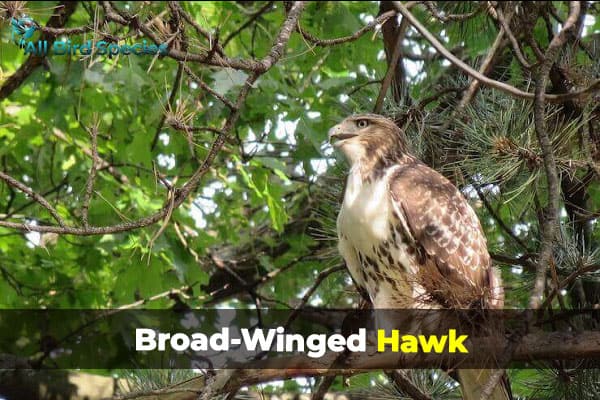
Migration Patterns
These hawks gather in large numbers during their migration. They leave late summer to early fall, heading south. Then, they return in spring. Their journey shows their strength and how important Arizona is for rest and food.
Dietary Preferences
In Arizona, Broad-winged Hawks eat small mammals, insects, and reptiles. Their diet shows how well they adapt to their surroundings. Having enough food is key for their health and helps them when they return to breed.
5. Rough-legged Hawk
The Rough-legged Hawk is a fascinating bird of prey. It stands out with its unique features and how it adapts. Learning about its traits lets us see its special place in Arizona’s ecosystem in the cold months.

Unique Features
This hawk has special physical traits. It has a feathered facial disk and a black carpal patch on its wings. It’s about 18 to 20 inches long and has a wingspan of up to 54 inches. These features help it blend in and hunt better.
Wintering in Arizona
Even though it’s an Arctic bird, the Rough-legged Hawk can be seen in Arizona during winter. It changes its diet to eat small rodents and birds. This shows how it can adapt to different places, even when its usual home is far away.
| Feature | Description |
|---|---|
| Length | 18 to 20 inches |
| Wingspan | Up to 54 inches |
| Distinctive Markings | Feathered facial disk, black carpal patch |
| Habitat in Winter | Found in Arizona during winter months |
| Diet | Small rodents and birds |
6. Northern Goshawk
The Northern Goshawk is a powerful bird in the Accipiter group. It has many special traits that make it a top hunter in its home. Its looks and hunting skills show why we need to know about the Northern Goshawk and its role in nature.
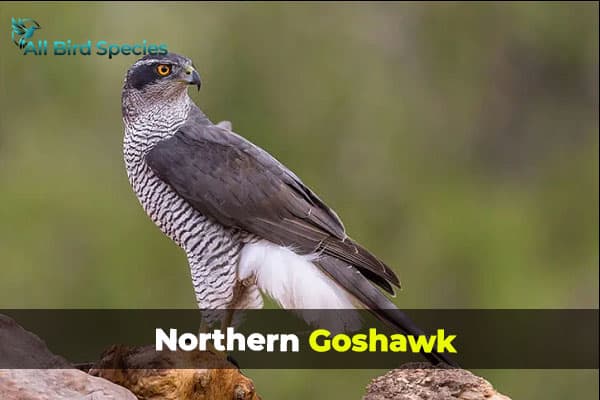
Identification Characteristics
The Northern Goshawk is big, measuring 24 to 29 inches long and with a wingspan of up to 52 inches. It has a strong body, dark gray back, and patterned belly. This helps it blend in with the forests it lives in. Its bright yellow eyes and unique face markings make it stand out. Watching it fly shows its amazing strength.
Habitat and Range
The Northern Goshawk lives in mature forests across the Northern Hemisphere, including Arizona. These forests are perfect for nesting and hunting. It can be found from North America to Eurasia, showing it can live in different climates. Knowing where it lives helps us see how it affects the ecosystem as a top bird predator.
| Characteristic | Description |
|---|---|
| Size | 24 to 29 inches |
| Wingspan | Up to 52 inches |
| Coloration | Gray back, patterned underparts |
| Eyes | Intense yellow |
| Habitat | Mature forests |
| Geographic Distribution | North America to Eurasia |
7. Swainson’s Hawk
The Swainson’s Hawk is a bird with amazing nesting habits and a varied diet. It lives in open areas of Arizona, where it finds perfect spots for nesting and hunting. Their nests are big and sit high up on trees or utility poles. This shows they like safe and high places to watch around them.

Breeding Habitats
Swainson’s Hawks make their homes in big grasslands and meadows full of food. When it’s time to nest, they look for tall trees to build their nests in. These spots are key for their safety and help them watch for danger.
They build their nests with twigs, grass, and other stuff they find. These nests are big and can be used for many years. This helps the hawks have a good place to raise their young.
Diet and Feeding Strategies
The Swainson’s Hawk eats many different things, showing how good it is at finding food. It mainly eats insects, small mammals, and sometimes even smaller birds like Burrowing Owls. They hunt by flying high to see their prey and then diving down fast to catch it.
They use warm air currents to stay up in the sky for a long time. This lets them search for food over a big area. This skill helps them do well in their home areas.
8. Ferruginous Hawk
The Ferruginous Hawk, known as Buteo regalis, is a big bird that birdwatchers love. It’s one of the biggest hawks that live on the ground. It’s about 20 to 26 inches long.

This hawk has reddish-brown feathers on its back and white feathers under its belly. These colors can look different from one hawk to another.
Physical Attributes
The Ferruginous Hawk has strong features that help it hunt. It has wide wings and a big body, perfect for flying high. Its feathers help it blend in with its dry surroundings, making it a great hunter of small animals and birds.
Nesting Preferences
These hawks like to nest on cliffs or in big, strong trees. They use twigs and grass to build their nests. This makes their nests safe and stable.
They pick these places so they can watch for food or dangers easily. This helps them stay safe and find food well.
Related Video:
9. Common Black Hawk
The Common Black Hawks is a big bird we often see in southern Arizona. It lives where there is lots of water, which it needs to survive. It loves places near rivers and wetlands, making it interesting for bird lovers and nature fans.

Habitat and Range in Arizona
In Arizona’s desert, the Common Black Hawk hangs out by rivers and wetlands. It goes where the water is, making it thrive. These spots are perfect for hunting and making a home, showing how well it adapts.
Dietary Habits
The Common Black Hawk eats a mix of things like small mammals, fish, and reptiles. It waits patiently and moves quietly to catch its food. By fitting in with its surroundings, it shows off its smart hunting skills.
10. Harris’s Hawk
The Harris’s Hawk catches our eye with its bright look and interesting social structure. It’s known for its social hunting skills. Unlike many hawks that hunt alone, this bird works well with others.
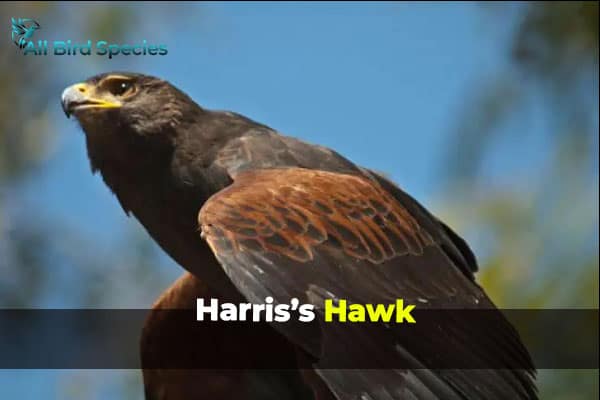
Social Structure and Hunting Techniques
The social life of the Harris’s Hawk is amazing. They often live in family groups, which helps them hunt better. This teamwork lets them catch bigger prey together, which is really cool.
- Hunts in groups of 2 to 6 hawks
- Coordinate attacks on prey
- Utilizes roles among members to maximize efficiency
Each hawk has a special job in the hunt. Some chase the prey, while others block its escape routes. This way of hunting shows how smart the Harris’s Hawk behavior is.
| Aspect | Harris’s Hawk Behavior |
|---|---|
| Group Size | 2 to 6 |
| Hunting Method | Cooperative strategies |
| Prey Type | Rabbits, rodents, and small birds |
| Role Allocations | Drivers, blockers, and catchers |
11. Gray Hawk
The Gray Hawk, known as Buteo plagiatus, is a bird we love to see in Arizona. It has a blue-gray back and pale belly. This makes it easy to spot. It’s about 20 inches long and has features that make it stand out to bird lovers.
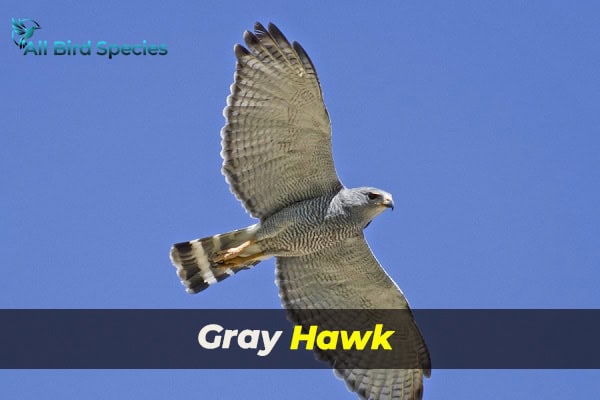
Distinctive Features
The Gray Hawk’s feathers are quite striking. Its blue-gray color and unique markings make it easy to recognize. It also has a special tail pattern that helps us spot it in the wild.
Habitat Preferences
The Gray Hawk lives in riparian forests and subtropical places. It likes areas full of lizards and small birds, which it eats. Knowing where it lives helps us understand its role in nature and how it survives.
| Feature | Description |
|---|---|
| Scientific Name | Buteo plagiatus |
| Size | Approximately 20 inches long |
| Coloration | Blue-gray back with pale underparts |
| Habitat | Riparian forests and subtropical areas |
| Diet | Lizards and small birds |
Check our Previous Articles:
| Crows Found in Florida |
| Hawks in South Carolina |
| Black Redstart: Charming European Songbird |
| Cuckoo bird- Cuculidae Family |
| Indian Runner Ducks: Everything You Need To Know |
Final Thoughts:
Exploring Arizona hawk species shows how important they are to our ecosystems. From the quick Cooper’s Hawk to the big Ferruginous Hawk, each one has special ways to live in their homes. This variety of hawks in Arizona makes our wildlife richer and tells us about our environment’s health.



